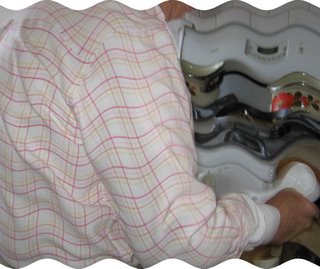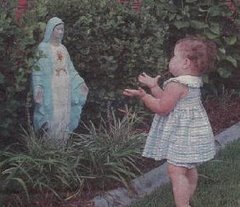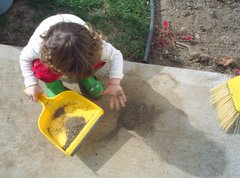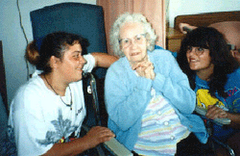 My Aunt T was the Tomato Lady. Forty years ago she would plant a couple of thousand tomato seeds in a hotbed, transfer them to other hot beds after they sprouted a few leaves, and then replant them in her large garden in early May. Some years Aunt T had over 1,500 tomato plants that produced basket after basket of tomatoes for each day during the harvest season from late June until October's first frost.
My Aunt T was the Tomato Lady. Forty years ago she would plant a couple of thousand tomato seeds in a hotbed, transfer them to other hot beds after they sprouted a few leaves, and then replant them in her large garden in early May. Some years Aunt T had over 1,500 tomato plants that produced basket after basket of tomatoes for each day during the harvest season from late June until October's first frost.Aunt T lived in a small two-bedroom house built in the 1920s and she was far from wealthy. Her fresh, great-tasting tomatoes provided cash during poor (and sometimes slightly better) economic times. I recently asked Aunt T's daughter about my own memories of visiting Aunt T and seeing her work long and hard at raising tomatoes--while still doing all the church laundry (remember the nice long altar-rail cloth?).
The first step was for Uncle C to build hotbeds in the ground in which delicate plants would be planted and grown in cold weather. Wood edges of the hot bed supported a wooden frame with glass windows, so the hotbed acted as a ground level greenhouse. At night during cold weather, Aunt T covered each window frame with gunny sacks and then with straw to prevent infiltration of cold air. During warm daytime weather, the frame would be lifted on the downwind side to allow gentle ventilation of the hotbed. On even warmer days, the entire window frame would be removed to expose the tomato plants to the hot rays of the sun.
For many years, I remember Aunt T used the original method of heating her hotbeds--fresh horse manure added as the bottom layer of the hotbeds. [Aunt T was very excited when in the 1950's she was able to buy electrical heating coils as a replacement for the bottom manure layer.]
The process began by collecting and storing fresh manure in a pile, then mixing the pile a couple of times and adding water to encourage fermentation during the ten days preceding use of the hotbeds. The well-fermenting manure was added to the bottom of the hotbed as a two to three foot layer before adding good soil as the top layer (with added Perlite) in which to plant the tomatoes. For a lot more information on building hotbeds see here, although I remember my Aunt T's hotbeds as more level to the ground for easier covering when cold weather was encountered.
Aunt T planted tiny tomato seeds in a single hotbed on a nice day in about the third week of February--dependent on what she read in the original Farmer's Almanac about the moon. The biggest problem with growing young tomato plants is that they become spindly and will "dampen off" and die because of fungi when the weather is cool and there is lots of moisture. Watering was done very sparingly while young tomato plants were growing. [I learned a long time ago that it was best to stunt young tomato plants by denying them water until they began to droop a little. Then the plants seemed to develop a more vigorous short stem to support further growth.]
Once the tiny plants had grown several leaves, they now were too closely spaced. Aunt T then transplanted the tiny tomato plants from the original hotbed to new hotbeds that had been prepared for more spacious plantings of young plants.
Aunt T was a big believer in "mira-gro." The final transplant to rows in her garden was done by first dipping the root in a solution of Miracle Gro and then planting it in the soil. A small amount of "mira-gro" was also added to the soil around the plant.
Even though the last frost date for Kansas City is about May 10, Aunt T would transplant tomatoes to her garden as soon as May 1, dependent on the immediate weather forecast. She would risk all her work to gain the financial advantage of being the first to bring homegrown tomatoes to the City Market.
Sometimes, she would err and the forecast was for frost after she had already planted the tomatoes. She always saved her old newspapers, and 6-layer newspaper tents had to be made to cover each
 vulnerable plant. [I remember helping Aunt T with this as a young girl, but I wasn't nearly as fast as my Aunt and Mother!]
vulnerable plant. [I remember helping Aunt T with this as a young girl, but I wasn't nearly as fast as my Aunt and Mother!]Ripe tomatoes are cleaner, more round, and more evenly ripe if they are suspended in air. So Aunt T always trimmed off the small lower branches (NOT the bigger leaves) with her fingernail. By early June (after continuous cultivating and watering), the tomato plants had grown tall enough to stake and tie so that they would not fall over when loaded with heavy tomatoes.
If there was good weather, Aunt T would call her neighbor down the street by June 20-25 to take fresh tomatoes to the City Market. Her favorite tomato became the JetStar because it was early, had lots of flesh, was very productive, didn't crack, and was easy to sell because of its superior taste. [The current price of 1/4 oz (2,000 to 2,800 seeds) of JetStar tomato seeds is now $70.80.]
Aunt T and her oldest daughter who told me this story worked very, very hard to earn every penny from their hotbed-germinated and garden-grown tomatoes. I'll always be impressed with Aunt T's and M's work ethic. I wonder whether anyone with a similar work ethic will take M's offer to furnish a new Tomato Lady with two free window frames from Aunt T's old hotbeds (some windows need replacing). [If we have another great depression, ......?]
Postscript: When my Aunt T died (she would now be well over 100 years old), I would have thought her skin would have been badly affected by the sun exposure she received during her lifetime of gardening. Not so, her face was as clear and fresh as if her over 90 years of life had been spent in a convent. You see, Aunt T always used a wide brim straw hat! Good advice for the younger gardener.








